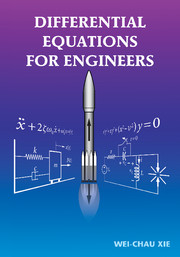Book contents
- Frontmatter
- Contents
- Preface
- 1 Introduction
- 2 First-Order and Simple Higher-Order Differential Equations
- 3 Applications of First-Order and Simple Higher-Order Equations
- 4 Linear Differential Equations
- 5 Applications of Linear Differential Equations
- 6 The Laplace Transform and Its Applications
- 7 Systems of Linear Differential Equations
- 8 Applications of Systems of Linear Differential Equations
- 9 Series Solutions of Differential Equations
- 10 Numerical Solutions of Differential Equations
- 11 Partial Differential Equations
- 12 Solving Ordinary Differential Equations Using Maple
- Appendix A Tables of Mathematical Formulas
- Index
Preface
Published online by Cambridge University Press: 05 June 2012
- Frontmatter
- Contents
- Preface
- 1 Introduction
- 2 First-Order and Simple Higher-Order Differential Equations
- 3 Applications of First-Order and Simple Higher-Order Equations
- 4 Linear Differential Equations
- 5 Applications of Linear Differential Equations
- 6 The Laplace Transform and Its Applications
- 7 Systems of Linear Differential Equations
- 8 Applications of Systems of Linear Differential Equations
- 9 Series Solutions of Differential Equations
- 10 Numerical Solutions of Differential Equations
- 11 Partial Differential Equations
- 12 Solving Ordinary Differential Equations Using Maple
- Appendix A Tables of Mathematical Formulas
- Index
Summary
Background
Differential equations have wide applications in various engineering and science disciplines. In general, modeling of the variation of a physical quantity, such as temperature, pressure, displacement, velocity, stress, strain, current, voltage, or concentration of a pollutant, with the change of time or location, or both would result in differential equations. Similarly, studying the variation of some physical quantities on other physical quantities would also lead to differential equations. In fact, many engineering subjects, such as mechanical vibration or structural dynamics, heat transfer, or theory of electric circuits, are founded on the theory of differential equations. It is practically important for engineers to be able to model physical problems using mathematical equations, and then solve these equations so that the behavior of the systems concerned can be studied.
I have been teaching differential equations to engineering students for the past two decades. Most, if not all, of the textbooks are written by mathematicians with little engineering background. Based on my experience and feedback from students, the following lists some of the gaps frequently seen in current textbooks:
• A major focus is put on explaining mathematical concepts
For engineers, the purpose of learning the theory of differential equations is to be able to solve practical problems where differential equations are used. For engineering students, it is more important to know the applications and techniques for solving application problems than to delve into the nuances of mathematical concepts and theorems. Knowing the appropriate applications can motivate them to study the mathematical concepts and techniques. However, it is much more challenging to model an application problem using physical principles and then solve the resulting differential equations than it is tomerely carry out mathematical exercises.
- Type
- Chapter
- Information
- Differential Equations for Engineers , pp. xiii - xviPublisher: Cambridge University PressPrint publication year: 2010



